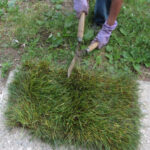You might argue that any unwanted plant growing surreptitiously in your cared-for sod is one of the dreaded lawn weeds. Before you reach for the lawn weed control spray, take note that one gardener’s turf scourge is another’s wild flower. In fact, weed determination is quite frequently in the eye of the beholder. For example, if your lawn is made up of Kentucky bluegrass, then fine or tall fescue would be considered weeds. At the same time, these types or weeds make up the lawns in other yards. Get an up close and personal introduction to your lawn weeds and — perhaps — gain a whole new appreciation for what is taking root. Then again, you might just want an edge to get rid of it.
Biology 101: Classification
The most elementary classification of lawn weeds points to two types of weeds: Monocot and dicot plants. Purdue University identifies some common monocots as being from the gramineae family (grasses, such as crabgrass, Bermuda grass, and tall fescue). Dicot plants include the basic broad-leaf weed plants the hobbyist knows as clover and dandelion.
Growth Cycles
Another common differentiation between the various types of lawn weeds is the growth cycle. For example, monocot crabgrass is an annual weed. It germinates, grows, goes to seed, and then dies off. The seeds must germinate in the lawn’s soil to start the cycle again. In contrast, biennial weeds complete this cycle in two growth seasons. The most feared lawn weeds are the perennial types. These weeds live through numerous growth cycles. Dicot dandelions are quintessential perennial weeds that come back season after season unless eradicated all the way to the root. Did you know that a close look at the weeds’ growth cycles actually gives you useful hints for management or eradication?
Lawn Weed Control Tips and Tricks
- Crabgrass. Crabgrass is a monocot. It is also an annual weed and therein lays its weakness. Keep the lawn mowed properly to cut down on the production of seeds. Improve the soil and so support your desired turf grass. In so doing, your lawn can actually out-compete the crabgrass (and other undesirable grasses like it) when it comes time to germinate.
- Dandelion. This type of weed is a perennial broad-leaf dicot. It is also — quite possibly — the bane of your existence. The weed’s deep taproots make it impossible to control with frequent mowing since the mechanical damage does not actually do away with the root. Back-breaking manual removal is the best option. Get to the weed before the flower creates seeds — or be prepared to do more lawn weeding next year.
- White clover. You are going to find white clover in lawns that are not fertilized. The University of California at Davis minces no words and points out that this type of weed is common in soils low on nitrogen. Combat the weed simply by fertilizing the soil to levels appropriate to your conditions; then watch the landscape become naturally inhospitable to the weed.
Are the Weeds Your Fault?
In a word: yes. Sure, you did not invite the seeds to visit your lawn, and you did not sow the various types of weeds taking up residence in your turf. Yet did you go out of your way to give your turf grass every advantage necessary to out-compete rival grasses? Did you allow it to become stronger, so that it could develop deeper roots that would leech nutrients away from germinating weeds? Do you employ proper lawn mowing techniques to maintain an optimal height — for your grass variety — that does not make access for weeds easy? Do you take the weed bull by the leafy horns and apply pre-emergence herbicides top combat weeds before they germinate?
If you answer “no” to one or more of these questions, you do indeed bear some responsibility for the lawn weeds currently having a blast in your turf. Now that lawn weeds identification has become easier, go out and take care of business!
Sources
Purdue University; “Purdue Master Gardener Guide to Common Lawn and Garden Weeds”
University of California at Davis; “How to Manage Pests”
More by Sylvia Cochran
5 Steps to Cultivating Green Lawns After Dethatching
How to Mow Your Lawn for Maximum Curb Appeal
Applying Pre-Emergent Herbicide for Weed Control




